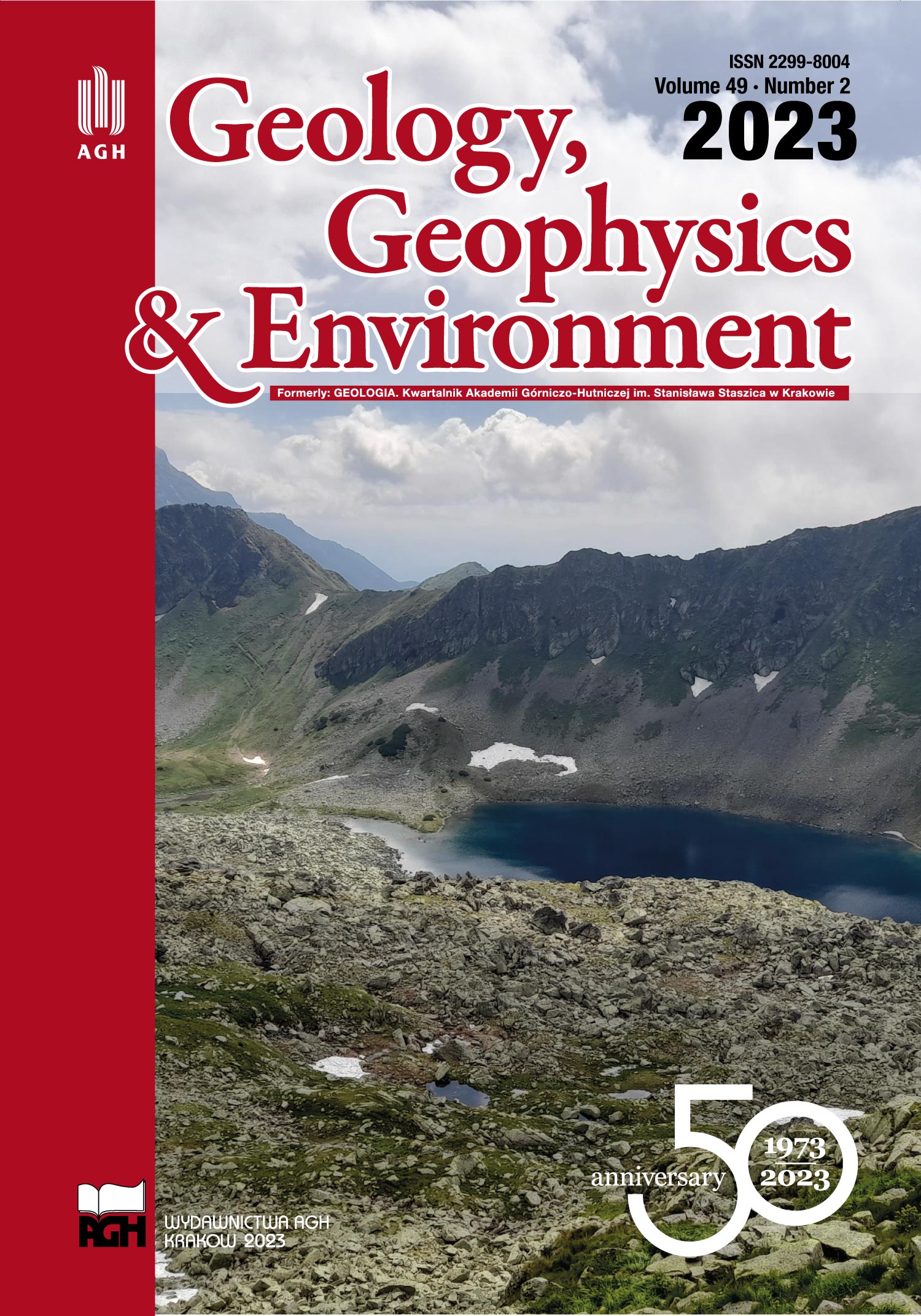Recognition of the flysch substrate using the electrical resistivity tomography (ERT) method to assess the effectiveness of the injection process
DOI:
https://doi.org/10.7494/geol.2023.49.2.197Keywords:
electrical resistivity tomography (ERT), monitoring, Carpathian flysch, injectionAbstract
During the construction of a section of the S-7 Lubień – Rabka-Zdrój dual expressway, located in the area of the Carpathian flysch (Carpathian Flysch Belt, South Poland), damage to the embankment was observed, as well as cracks and depressions in the new pavement. An analysis of the geological and engineering conditions in the area of the road section under construction showed the existence of a complex tectonic structure of the flysch formations, a shallow groundwater table, and numerous landslides. In order to stabilize the road substrate, it was decided to carry out injections, and the locations of these injections were initially geotechnically tested. However, due to the high variability of the geological structure, the target method employed was electrical resistivity tomography (ERT), which performed the survey in two stages. In Stage I, the geoelectrical/geochemical structure of the near-surface zone was identified, and the probable causes of road damage were indicated. This stage was completed by performing the stabilization and sealing process of the ground with an injection mixture. In Stage II, studies were carried out to evaluate the effectiveness of the injection process. The ERT method effectively identified the shallow geological structure and, in particular, delineated the zone of strong fractures in the flysch and areas associated with faults. Using the electrical resistivity tomography method, it was also possible to determine the injection mixture’s approximate penetration depth and the loosening zone’s degree of filling.
Downloads
References
Apuani T., Giani G.P., d’Attoli M., Fischanger F., Morelli G., Ranieri G. & Santarato G., 2015. Assessment of the efficiency of consolidation treatment through injections of expanding resins by geotechnical tests and 3D electrical resistivity tomography. The Scientific World Journal, 2015, 237930. https://doi.org/10.1155/2015/237930.
Archie G.E., 1942. The electrical resistivity log as an aid in determining some reservoir characteristics. Transactions of AIME, 146(01), 54–62. https://doi.org/10.2118/942054-G.
Cheytani M. & Chan S.L.I., 2021. The applicability of the Wenner method for resistivity measurement of concrete in atmos-pheric conditions. Case Studies in Construction Materials, 15, e00663. https://doi.org/10.1016/j.cscm.2021.e00663.
Czado B. & Pietras J.S., 2012. Rozpoznanie geotechniczne podłoża przez sondowania statyczne i dynamiczne ‒ porównanie oporów penetracji stożka [Geotechnical soil testing by CPT and dynamic probing – comparison of the cone penetration re-sistances]. Czasopismo Techniczne. Budownictwo, 109(20), 3-B, 21–33.
Dahlin T., 1996. 2D resistivity surveying for environmental and engineering applications. First Break, 14(7), 275–283. https://doi.org/10.3997/1365-2397.1996014.
Dahlin T., 2001. The development of DC resistivity imaging techniques. Computers & Geosciences, 27, 1019–1029. https://doi.org/10.1016/S0098-3004(00)00160-6.
Gutiérrez-Martín A., Yenes J.I., Fernández-Hernández M. & Castedo R., 2021. Stabilization methodology in foundation soils by ERT-3D application in Estepona, South Spain. Applied Sciences, 11(10), 4455. https://doi.org/10.3390/app11104455.
Hasan M., Shang Y., Meng H., Shao P. & Yi X., 2021. Application of electrical resistivity tomography (ERT) for rock mass quality evaluation. Scientific Reports, 11, 23683. https://doi.org/10.1038/s41598-021-03217-8.
Jouen T., Clément R., Henine H., Chaumont C., Vincent B. & Tournebize J., 2018. Evaluation and localization of an artificial drainage network by 3D time-lapse electrical resistivity tomography. Environmental Science and Pollution Research, 25(24), 23502–23514. https://doi.org/10.1007/s11356-016-7366-x.
Kremer T., Vieira C. & Maineult A., 2018. ERT monitoring of gas injection into water saturated sands: Modelling and inversion of cross-hole laboratory data. Journal of Applied Geophysics, 158, 11–28. https://doi.org/10.1016/j.jappgeo.2018.06.001.
Loke M.H., 2010. Rapid 2D Resistivity & IP Inversion Using Least-Squares Method. Tutorial Geotomo Software. http://www.geotomosoft.com/downloads.php [access: 1.09.2022].
Loke M.H., Ackworth I. & Dahlin T., 2003. A comparison of smooth and blocky inversion methods in 2D electrical imaging surveys. Exploration Geophysics, 34(3), 182–187. https://doi.org/10.1071/EG03182.
Loke M.H., Chambers J.E., Rucker D.F., Kuras O. & Wilkinson P.B., 2013. Recent developments in the direct-current geoelec-trical imaging method. Journal of Applied Geophysics, 95, 135–156. https://doi.org/10.1016/j.jappgeo.2013.02.017.
Majer E., Sokołowska M. & Frankowski Z. (red.), 2018. Zasady dokumentowania geologiczno-inżynierskiego (w świetle wyma-gań Eurokodu 7). Państwowy Instytut Geologiczny – Państwowy Instytut Badawczy, Warszawa.
Martínez-Pagán P., Gómez-Ortiz D., Martín-Crespo T., Manteca J.I. & Rosique M. 2013. The electrical resistivity tomography method in the detection of shallow mining cavities. A case study on the Victoria Cave, Cartagena (SE Spain). Engineering Geology, 156, 1–10. https://doi.org/10.1016/j.enggeo.2013.01.013.
Pasierb B., Grodecki M. & Gwóźdź R., 2019. Geophysical and geotechnical approach to a landslide stability assessment: a case study. Acta Geophysica, 67(6), 1823–1834. https://doi.org/10.1007/s11600-019-00338-7.
Samouëlian A., Cousin I., Tabbagh A., Bruand A. & Richard G., 2005. Electrical resistivity survey in soil science: a review. Soil and Tillage Research, 83(2), 173–193. https://doi.org/10.1016/j.still.2004.10.004.
Sokołowska M., Chada M., Roguski A. & Majer E., 2017. Ocena badań geologiczno-inżynierskich wykonanych na potrzeby inwestycji drogowych w latach 2007–2016. Przegląd Geologiczny, 65(10/2), 672–677.
Downloads
Published
Issue
Section
License
Authors have full copyright and property rights to their work. Their copyrights to store the work, duplicate it in printing (as well as in the form of a digital CD recording), to make it available in the digital form, on the Internet and putting into circulation multiplied copies of the work worldwide are unlimited.
The content of the journal is freely available according to the Creative Commons License Attribution 4.0 International (CC BY 4.0)










